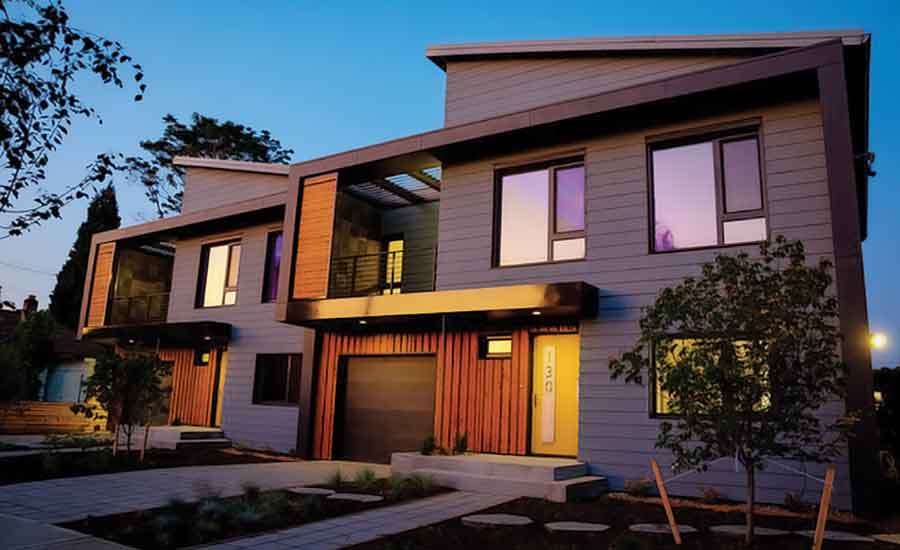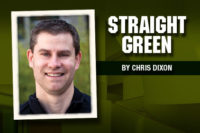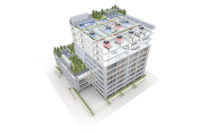"Houses so efficient, they can be heated with nothing more than a hair dryer!”— a statement you will find over and over again in searching the Internet for “Passive House.” So outlandish, it seems more marketing hype that reality. But Allen Gilliland, owner of Silicon Valley’s One Sky Homes and Passive House designer and contractor, puts this claim to a test in a YouTube video for a 3,200-square-foot Passive House he designed and built. In the video, Gilliland suspends a 1,600 watt hair dryer in the home’s return air plenum, turns off the home’s heating system, turns on the hair dryer (at 6:30 PM and 51 degrees Fahrenheit outside and dropping) and comes back the following morning to check the results. When he returns, the outdoor temperature is measured at 36 degrees F. Once inside, he makes a beeline to the home’s thermostat, which corroborates an outdoor temperature of 36 degrees and shows an indoor temperature of a balmy 70. Amazing.
Passive House is an ultra-energy-efficient building standard developed in Germany (using U.S. and Canadian groundwork) in the 1990s by Wolfgang Feist, and introduced in the U.S. in the early 2000s. It is a standard that has few, and very simple, requirements: super-insulate the building envelope, make it nearly airtight, eliminate thermal bridges, and use super-efficient windows. The standard’s promise in following the strict rules is a building that will use 90 percent less energy for heating and cooling than a conventional building.
There are an estimated 40,000 plus homes built to the standard in Europe, and it is gaining momentum in the U.S. as well, thanks to people like Gilliland and the efforts of the Passive House Institute US.
Katrin Klingenberg, co-founder and Executive Director of PHIUS, built the first Passive House in the U.S. in 2002 in Illinois. At that time Klingenberg was using, and promoting, the German version of Passive House and finding it somewhat difficult to follow, resulting in homes that did not perform as promised and high costs without justifiable payback periods. The German standard is based on a central European set of climate conditions, energy costs and construction costs. To work in the U.S., a one-size-fits-all standard would need to be dumped. So Klingenberg set out to develop a U.S.-specific Passive House standard, a standard three years in the making, just rolled out for use: PHIUS+ 2015. Klingenberg stresses that the U.S. standard shares the exact same principles as the German version, but has simply been modified to accommodate different climate zones and to ensure efficiency measures employed will have reasonable pay back relative to operational savings.
Can Too Much of a Good Thing be a Bad Thing?
Passive House has received its share of criticisms over the years. There are success stories, to be sure, but there are also some failures. One of the promises made using this standard is that occupants will always be comfortable. In some cases, designing to the standard has resulted in so much insulation and south facing glass that homes uncomfortably overheat. There have been reports of indoor air quality problems as well, due to the near perfect air tightness required. And there are lots of stories about the exorbitant cost of all that added insulation and those expensive super-efficient windows (most required to be shipped in from Germany, because few North American manufacturers are able to meet the strict requirements).
John Straube of Building Science Corp, in a 2009 article about the German Passive House, questioned many things about the standard, and pointed out that many of the hard line requirements are unnecessary to do in achieving highly energy-efficient results for U.S. homes. In a follow up article, a response to the hundreds of emails and online postings expressing outrage that Straube challenge the “Gospel of Wolfgang.” he writes:
“… the requirement to limit the heating energy demand to only 15 kWh/m2/yr is perplexing: depleting energy resources and environmental damage are already limited by the 120 number, why constrain the design further with no reduction in energy? And what is special about 0.6 ACH@50Pa? If a builder can deliver a house that uses less than 120 kWh/m2/yr, with 1.5 ACH@50, why does this matter?”
Straube’s company, Building Science Corporation, has proven that dogmatic adherence to the Passive House standard doesn’t really matter all that much. Through its affiliation with DOE’s Building America Program, BSC has measured the performance of dozens of Building America homes in every climate zone in America—all of which achieve up to 50 percent energy savings over current energy code requirements.
Martin Holladay, a self-described jack of all green building trades and popular Green Building Advisor blogger, agrees with Straube. In his “Pretty Good House Manifesto,” Holladay offers 10 principles for ultra-energy efficiency that are flexible and affordable. Among them, he likes the 5:10:20:40:60 R-value rule for insulating a building, numbers that correspond to windows, slab on grade, basement walls, above grade walls, and roof, respectively. Easily and affordably accomplished in the U.S. He cautions against spending money on expensive building components that yield small gains, saying: “Some energy-obsessed designers spend weeks trying to track down a European window that will nudge their design from 16 kWh/m2 per year to 15kWh/m2 per year—a difference that might save $12 a year in a 2,000-square-foot house.” And he thinks that windows should be sized and oriented for comfort and delight, and not oversized on southern elevations.
Conclusion
Not that anyone needed yet another green building standard, but Passive House is here and seems to be gaining a fair amount of traction in the world. A U.S.-specific version makes good sense to me, perhaps a compromise for those that want to be able to claim Passive House certification without religious adherence to the European version. For those that want to be able to confidently say their home can be heated with nothing more than a hair dryer, this might be for them. For the rest of us, DOE’s Building America and Holladay’s Pretty Good Home Manifesto is more attainable and more affordable and will save nearly as much energy as going full Passive House.






